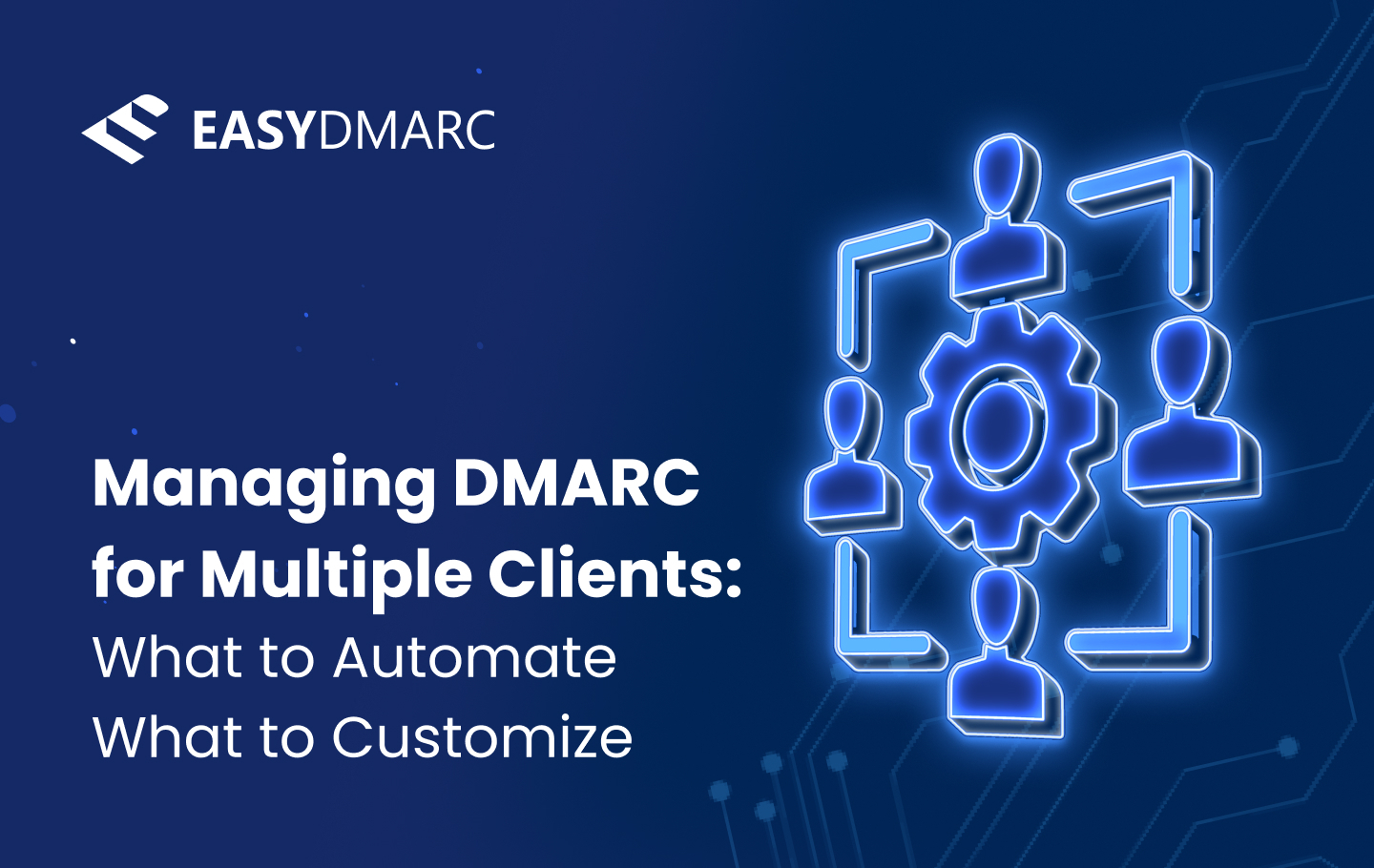If you’ve ever tried managing DMARC for more than one domain, you know how quickly things can get complicated. Now imagine doing it for dozens of clients at once, each with their own email setup, policies, and priorities. With a broad network of clients, multi-client DMARC management becomes a constant balancing act for MSPs and large organizations.
Some tasks are perfect for automation because they save time and reduce errors. Others need some personalization to match each client’s specific needs. EasyDMARC, a recognized leader in DMARC management solutions, makes it easier to manage that balance so you can protect every domain without losing control of the details.
Why Multi-Client DMARC Management Requires a Different Approach
Managing DMARC for one domain is fairly simple. But when you’re responsible for dozens or even hundreds of clients, the work changes completely. In multi-client DMARC management for MSPs, no two clients are the same. One might have a complicated DNS setup with multiple email providers, while another has a simple setup but strict p=reject rules. Some will need your guidance to understand what DMARC does, others might only care about seeing the results.
Without one central system to keep everything in check, it’s easy to miss policy updates, make mistakes in DNS records, or overlook authentication issues. Managing DMARC for many clients means having a process that works for different setups, keeps things organized, and spots problems early.
Core Challenges of Multi-Client DMARC Management
When you manage DMARC for many clients, you’re juggling different policies, setups, and levels of understanding. Here are some of the most common challenges MSPs face:
- Keeping policies consistent – Each client’s DMARC policy needs to match their current email activity and security needs. Some clients may be ready for strict enforcement, while others are still in testing mode. Without a consistent policy, your domain is likely to stay on an outdated policy that leaves it open to spoofing.
- Sorting through large volumes of reports – Every domain sends regular DMARC reports that show who’s sending email on its behalf and whether those emails are passing authentication checks. When you multiply that by dozens of clients, the data can quickly become overwhelming. That’s why you need to figure out which issues are urgent and which can wait, especially if you’re doing it manually.
- Avoiding DNS errors – DMARC depends on correct DNS settings, but these records can be accidentally misconfigured when updates are made. Even a small typo can cause email failures, so spotting these errors across many domains is difficult without the help of a monitoring tool.
- Explaining changes to non-technical clients – Many clients aren’t familiar with how DMARC works, so technical updates can confuse them. You might need to explain why you’re moving their policy from p=none to p=quarantine, or why a failed SPF check is causing delivery issues and make it easy for them to understand.
That’s why managing DMARC for many clients works best with an organized process and the right tools. They make the job easier, help you stay organized, and make it simpler to keep clients informed. Now let’s go over which parts you can automate to save time and reduce problems.

What to Automate in Multi-Client DMARC Management
When you’re managing DMARC for many clients, some tasks are perfect for automation because they repeat often and take up a lot of time. Automating these steps helps you work faster, stay organized, and avoid mistakes that can slip in when everything is done manually.
Here are a few processes worth automating:
- Parsing DMARC aggregate reports – These reports show which email sources are passing or failing authentication. Automated tools can collect them from all your clients, sort the data, and give you easy-to-read summaries instead of raw XML files.
- Applying bulk policy updates – If you need to adjust policies for multiple clients at once, automation can make the changes in a few clicks rather than updating each domain one by one.
- Sending authentication failure alerts – Automated alerts let you know right away when something fails, so you can fix the problem before it affects deliverability.
- Running SPF and DKIM checks – Regular checks confirm that records are set up correctly and help spot misconfigurations early.
Aside from saving time, automation also frees you up to focus on the client-specific work that really needs your attention. For more details on tools that can help with this, check out our blog on Best Tools to Automate and Monitor Your DMARC Implementation.
What to Customize for Each Client
Automation can handle a lot, but it can’t replace the decisions that need to be made for each client’s specific situation. Every domain has its own email setup, security needs, and business rules, and these require a more hands-on approach.
- Gradual policy enforcement – Moving from p=none to p=quarantine and finally to p=reject should be done in steps. This gives you time to monitor results and fix any issues before applying stricter rules.
- Custom reporting addresses – Some clients prefer DMARC reports to go to their internal team, while others want you to handle them directly. Setting up the right reporting address ensures the right people see the right information.
- Whitelisting trusted senders – If a client works with specific third-party services, those sending sources need to be marked as trusted so their emails don’t get blocked.
- Meeting industry-specific requirements – Sectors like finance, healthcare, or government often have extra compliance rules. Customizing policies and records for these provides both security and regulatory compliance.
By adjusting these areas to each client, you make sure DMARC is not only protecting their domain but also working smoothly with their day-to-day email operations.
The Role of Centralized DMARC Tools
Managing DMARC for many clients can be unnecessarily complicated if you’re jumping between different systems and setups. A centralized DMARC tool solves this by putting everything in one place, so you can work faster and avoid missing important updates.
With a single dashboard, you can:
- View all client domains at once – Instead of logging into each account separately, you see every domain you manage in one view.
- Update policies from one location – If you need to adjust enforcement levels for several clients, a centralized tool lets you do it in just a few clicks instead of repeating the same steps over and over.
- Control who can access what – Role-based access means your team members only see the clients and settings they need to work on.
- Get alerts in one stream – See important issues right away, without digging through multiple email inboxes or reports.
With EasyDMARC, MSPs can manage all their clients under one account while still keeping each client’s data and settings separate. This makes it simple to run quick checks like a DMARC Lookup to verify domain alignment. For ongoing monitoring and full-service management, Managed DMARC provides the tools to keep every domain secure with less manual work.
Best Practices for MSPs Managing DMARC
Managing DMARC for multiple clients is much easier when you follow a simple, consistent approach. Here are some practices that can help you stay organized and keep every domain secure:
- Use a set onboarding process – Have a checklist for every new client. This can cover domain verification, adding DMARC, SPF, and DKIM records, and confirming all sending sources. It saves time and ensures you don’t overlook important steps.
- Check records regularly – Run lookups on a regular schedule to spot missing records, outdated policies, or unauthorized senders before they cause email issues.
- Focus on urgent issues first – Some alerts need your attention right away, like authentication failures that could block legitimate emails or allow spoofing. Deal with these first to protect deliverability.
- Keep clients in the loop – Even if they’re not technical, a quick explanation of their DMARC reports helps them understand what’s happening and why certain changes are needed.
By building these habits into your workflow, you’ll save time, prevent mistakes, and make DMARC easier for clients to trust and support.
How to Choose the Right Multi-Client DMARC Management Tool
The right DMARC platform can save you hours of work and prevent costly mistakes, but not every tool is built for managing multiple clients. When you’re comparing options, here are a few things to look for:
Scalability: Make sure the platform can handle the number of domains you manage now and grow with you as you add more clients.
Strong automation features: Look for tools that can automate repetitive tasks like parsing reports, applying policy updates, and sending alerts.
Flexibility for customization: Even with automation, you’ll still need to adjust settings for each client’s needs, from policy enforcement steps to custom reporting addresses.
Integration with your existing systems: The tool should work smoothly alongside your current email, security, and client management systems.
Using Managed DMARC, you can automate the tasks that save time while still adjusting settings to fit each client’s needs. This way, you work efficiently across all domains without giving up the precision required for different setups.

Balancing Speed and Precision in DMARC Management
Managing DMARC for many clients is a balancing act. You need to work efficiently without losing sight of each domain’s needs. Automation takes care of the everyday tasks in the background, freeing you up to focus on the changes and decisions that matter most. Customization makes sure each client’s setup matches how they send email and the level of protection they need.
When everything runs through a centralized tool, it all feels more manageable. Updates are made in one place, reports are easier to understand, and any problems stand out right away. With EasyDMARC, you can keep all your clients under one roof, protect their domains, and help their emails reach the inbox without extra complexity.
Frequently Asked Questions
DMARC tools for managing multiple clients save time, reduce mistakes, and make it easier to keep track of every client’s domains in one place. Features like centralized dashboards, automated alerts, and quick record lookups mean you can spot problems faster and keep all domains secure without juggling multiple systems.
Automation works best for routine tasks like collecting and parsing reports, sending failure alerts, and applying bulk policy updates. Customization is key for steps that depend on the client’s needs, such as adjusting enforcement levels, setting up custom report addresses, or adding trusted senders.
EasyDMARC lets you manage all clients from a single account while keeping their data and settings separate. You can run quick checks like DMARC and SPF lookups, set up automated alerts, and adjust each client’s policy as needed, all without switching between different platforms.
It’s a good idea to review policies at least every few months, or sooner if the client changes their email providers or sending practices. Regular reviews make sure the policy still fits their needs and offers the right level of protection.


